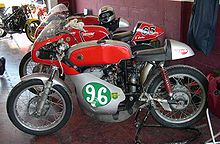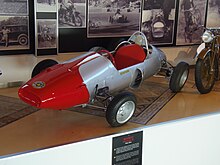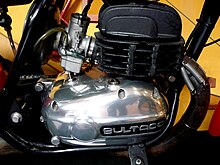
Bultaco Motorcycles

 |
|

Bultaco TSS125 road racer
|
|
| Industry | Motorcycle Electric motorcycles |
|---|---|
| Fate | active |
| Founded | 1958 |
| Defunct | closed in 1983, reopened in 2014 |
| Headquarters | Barcelona, Spain |
|
Key people
|
Francisco Xavier Bultó |
| Products | Bultaco Tralla 101 (1959) Bultaco Sherpa (1960) trials bikes Bultaco Pursang (1965) Motocross bikes Bultaco Metralla Bultaco Alpina Bultaco Frontera Bultaco Mercurio (1960) Bultaco Matador Bultaco Astro Bultaco El Montadero Mk II Bultaco El Tigre Other Models: Bultaco Streaker, Bultaco Mini (mini-bike), Bultaco Lobito, Bultaco Pomeroy |
| Website | www |

Bultaco was a Spanish manufacturer of two-stroke motorcycles from 1958 to 1983. In May 2014, a new Bultaco was announced, and the company will be selling electric-powered street motorcycles from 2015.
The R&D department will be based in Madrid while the factory will be located in Barcelona.
Origins
The origin of the Bultaco motorcycle company dates back to May 1958. Francesc "Paco" Bultó was a director of the Montesa motorcycle company founded in 1944. After several years of steady growth and road racing success, in 1957 Montesa moved to larger facilities. The move was protracted, disrupting production and was followed by a downturn in the Spanish economy. This slump brought to a head disagreements between Bultó and the other senior director Pere Permanyer. As an economy measure, Permanyer (the majority shareholder) felt that the company should withdraw from racing. Bultó, the driving force behind the racing program and responsible for much of the company’s technical expertise was vehemently opposed. Failing to reach a compromise, Bultó decided to leave Montesa to concentrate on his other business interests. Perhaps unsurprisingly, the majority of Montesa's racing department left shortly afterwards as well.
Bultaco is formed
The suggestion to form a new company is said to have come a few days later when Sr. Bultó was invited to a meeting by several of the former staff of Montesa's racing department. Keen to return to racing, they persuaded him that their greatest hope lay in forming a new company. Setting up shop in very primitive conditions at an old farm owned by Bultó, things developed quickly. On March 24, 1959, Bultaco held a press day and launched its first bike, the road-going 125cc Bultaco Tralla 101, named after a Spanish word for whip. Just two months later Bultaco entered its first Spanish Grand Prix taking seven of the first ten places.
The company name and logo
"Bultaco" comes from combining the first four letters of Sr. Bultó's surname with the last three of his nickname "Paco". The name was a suggestion of one of Bultaco's premier racers, and close friend of Sr. Bultó, John Grace from Gibraltar. CEMOTO is an acronym for "Compañia Española de Motores". The other part of the company logo, the "Thumbs up" symbol, came after Sr. Bultó witnessed British motorcycle racer David Whitworth giving the signal to his pit crew to signify that all was well. Sete Gibernau used to have this on the back of his crash helmet when he raced MotoGP.
In 1998, rights to the Bultaco name were purchased by Marc Tessier, who used it to help launch a range of purpose-built trials motorcycles from his company Sherco Moto S.A.R.L. The bikes were initially named Bultaco Shercos. In 2000, the bikes became 'Sherco by Bultaco', and in 2001 the Bultaco name was dropped altogether. The US trademark is now owned by HDW Enterprises, parent company of a parts and repair specialist for vintage Bultacos.
As of 2017, Bultaco produces electric motorbikes in Barcelona, Spain, also the site of the original 1958 factory.
Notable products


Although they made road and road racing motorcycles, the company had its greatest success with models for off-road competition; the Pursang for motocross, the Matador for enduros, the Sherpa T for observed trials competition, and the Astro for short flat-track.
Perhaps the most famous Bultaco model is the Sherpa T, a trials bike, which revolutionised the sport in the 1960s. At that time trials was almost exclusively a British sport using big heavy four-stroke machines. Irish trials ace Sammy Miller teamed with Bultó to produce a lightweight two-stroke machine which, overnight, rendered the heavy four-strokes obsolete. Miller won the gruelling Scottish Six Days Trial in 1965, and then repeated the feat with wins in 1967 and 1968. He also claimed the European Trials Championship in 1968 and 1970. This coincided with and, perhaps, stimulated the growth in the popularity of trials in Europe and later the USA, which provided a lucrative market for Bultaco in the years to come. Bultaco dominated the World Trials Championship in the 1970s, winning the title eight times, and winning the Scottish Six Days Trial four times.
Bultaco's premier model in the USA, the Pursang, was an excellent handling and powerful 250 cc competition model that was competitive in virtually any type of speed-based off-road competition. The Pursang range was later expanded to 125 cc, 360cc and 370 cc.
The Bultaco Astro was a very popular short-track racer in the United States, and was used by many AMA Grand National Number 1 holders in the US in pursuit of their championships, including Gene Romero, Kenny Roberts, Jay Springsteen, and hundreds of other top-class competitors. The Astro had a superb power-band, perfectly suited for short-tracks, and some half-miles as well.
Bultaco motorcycles were mainly powered by single-cylinder, air cooled, two-stroke engines, but they also made water cooled powerplants. The rider was required to mix the oil and gasoline manually. Built in Barcelona, Spain, Bultaco motorcycles were exported throughout the world, but their largest market ultimately became the USA, allowing aspiring racers to purchase legitimately competitive motorcycles without modification. The Bultaco engine & transmission were universally interchangeable between models and engine capacities; one could replace the cylinder from a 175 cc engine with a 200 cc, 250 cc, 350 cc or even 360 cc capacity Bultaco cylinder. As Bultaco produced the cylinders, pistons, rings & cylinder heads for all engine capacities, no aftermarket parts were required, as with other brands.
Due to industrial unrest and market pressures, Bultaco production closed in 1979. The factory reopened in 1980, but closed again in 1983. A new series of electric Bultacos was announced mid-2014, and it began sales in 2015.
Former MotoGP star, Sete Gibernau, is the grandson of the founder of Bultaco, Paco Bultó.
History
The Catalans Pere Permanyer and Francisco Xavier Bultó Marquis , better known as Don Paco , father of Alvaro Bultóand grandfather of Sete Gibernau , founded in 1944 , the motorcycle brand Montesa . Don Paco left this company due to theabandonment of the competition, believing that innovation in motorcycles was intimately linked to the world of competition, and founded the 17 of maypole of 1958 Bultaco on Barcelona .
The brand name is an invention of Bultó own (many people believe, erroneously, that the pilot must Gibraltar John Grace , who thought it would be a combination of the name of the founder, Bultó , and his name, Paco ), which already he used it for years as its particular telegraphic address . The particular logo , conceived by Don Paco, is a finger thumb sign that all is well.
The first model was a sport motorcycle called Bultaco Tralla 101 . After several developments thereof (Tralla Sport or TS, Tralla Super-Sport or TSS, the latter a single model for competition), was launched in 1964 the famous Shrapnel 62 of 200 cc, culminating four years after the most famous road machines brand: Mk2 shrapnel 250 cc.
In 1964 Bultaco was introduced in the market and competition bikes trial with the model Sherpa . It can be considered the Sherpa S two - stroke as the first motorcycle manufactured specifically for the practice of this sport. They signed the pilot Sammy Miller to compete and, despite the unfavorable bets that made the press, managed to win the first race they competed, the first time a non - scooter overcame British .
The latest model who took the mark of rampant finger was the Streaker , a motorcycle that incorporated at that time and disc brakes front and rear, something unusual so far as they had always used drum brakes.
Finally, Bultaco disappeared in 1983 after a major crisis (in which the Ministry of Industry forced to buy Honda Montesa Bultaco mark), along with other brands such as OSSA and Mototrans (manufacturer Ducati in Spain). Other Spanish brands such as Puch , Montesa and Sanglas were absorbed by the arrival on the market of Japanese brands like Suzuki , Honda and Yamaha , respectively.
Bultó asked the management of Montesa, with JL Milá in charge, the commercial rights to the logo and brand of Bultaco, alleging that they had no value for Honda. Montesa granted for free that cession of industral property and it was thanks to this transaction , which in 1999 the mark Derbirevived to Bultaco with a reissue of the Bultaco Lobito and the launch of a line of sportswear with the logo.
Bultaco reborn with electric motorcycle
Bultaco reborn in 2014 after more than 30 years after his disappearance, denominating Bultaco Motors, and commitment to electric motorcycles. Bultaco launches Rapitán and Rapitán Sport two naked versions born fruit of the work of R & D for four years of the company LGN TECH Design (spin off of the Carlos III University ) and Bultó family. 2 Both bikes' made in Spain 'hit the market in 2015. the manufacture of motorcycles will be in Barcelona and contro R & D in Madrid. 3 the first steps of these two naked occurred precisely at the first World Championship of electric motorcycles organized by the FIM in 2011 .
Bultaco in the competition
Motorcycling world
- 50 cc
- 1976 Angel Nieto
- 1977 Angel Nieto
- 1978 Ricardo Tormo
- 1981 Ricardo Tormo
Trial
- European Championship
- 1968 Sammy Miller
- 1970 Sammy Miller
- 1973 Martin Lampkin
- 1974 Malcolm Rathmell
- World championship
- 1975 Martin Lampkin
- 1976 Yrjo Vesterinen
- 1977 Yrjo Vesterinen
- 1978 Yrjo Vesterinen
- 1979 Bernie Schreiber
Bultaco models
Older models
- Bultaco 49 (1970)
- Bultaco Alpina (1971) A bike trail predecessor. This model was created in conjunction with the Moto Alpina Unit of the 9th Brigade Troops Relief Spanish Red Cross for their participation as Rescue Unit 6 Days TT Navacerrada in 1970. There is a replica of this model the Motorcycle Museum of Basella.
- Bultaco Astro (1971)
- Bultaco Bandido
- Bultaco Brinco (1973)
- Bultaco Campera (1961)
- Bultaco Chispa (1974)
- Bultaco Conqueror (1967)
- Bultaco El Bandido (1968)
- Bultaco The mounting block (1968) was like a dirt bike
- Bultaco El Tigre (1969)
- Bultaco Frontera (1975), enduro, the had 125, 250 and 370cc, the series begins with the Mk.9 the first to the last Mk.12TT was manufactured.They used to be red the first models, except some blue series Mk.10 and all the latest Mk.11 series in blue or back Mk.11A white. La Frontera 370 Gold Medal was made in gold.
- Bultaco Junior (1966)
- Bultaco Lobito (1966)
- Bultaco Matador (1965)
- Bultaco Mercurio (1960)
- Bultaco Metisse (1964)
- Shrapnel Bultaco 62 (1962)
- Shrapnel Bultaco Mk.2 (1966) was not a just economic motorcycle at the time, it was one of the pioneers, with great features that everyone wanted. The only drawback so to speak was the price as in 1966 exceeded 29,000 pts.
- Shrapnel Bultaco GT (1974)
- Shrapnel Bultaco GTS A (1977) (yellow) / GTS B (1979) with alloy wheels, disc brakes on both wheels, more modern body and gray or red metalizdo
- Bultaco Pursang (1967) the variety dirt bike
- Bultaco Saturno (1964)
- Senior bultaco
- Bultaco Sherpa (1960) the trial bike, the first were red, and the latest blues, won many championships in Spain and the world, with Martin Lampkin among others
- Bultaco Sweden (1966) or
- Bultaco Streaker 75 and 125 (1977) Road
- Bultaco Tiron (1971)
- Bultaco Whiplash (1959)
- Bultaco TSS (1960)
(Apart from these models also prototypes were designed as Bultaco Gaviota and Montjuich )
Current models
- Bultaco Astro
- Bultaco Lobito
- Bultaco Sherco
- Bultaco Rapitan
- Bultaco Rapitan Sport
- Bultaco Anderica "legend"
No models found
